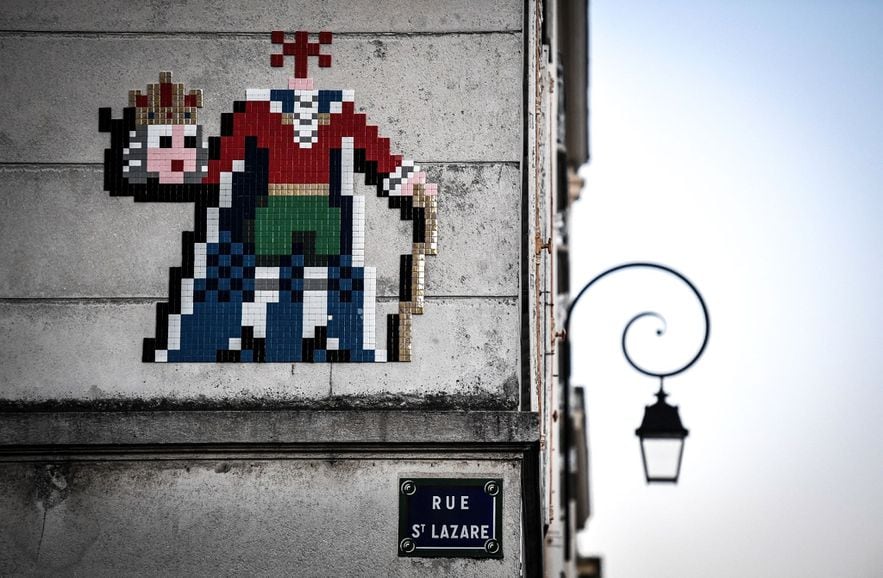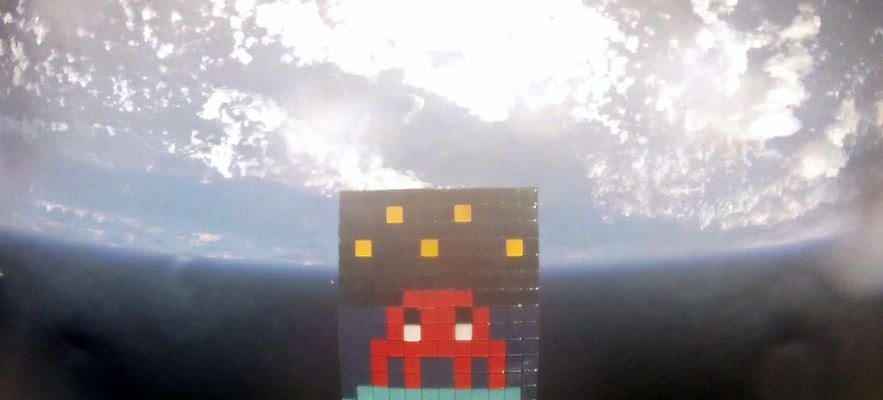The address is transmitted like a secret, through lip service. Almost a gift to those who appreciate it. The intersection of rue du Bac and rue de Grenelle. In the blink of an eye, here we are, in the heart of the very popular 7th arrondissement of Paris: a beautiful alignment of blond Haussmannian facades, a chic brasserie. In a corner of the intersection, a pharmacy stands next to a neighborhood supermarket. Opposite, a trendy drugstore where black soap costs as much as a bottle of Aligoté Burgundy. You have to raise your head, smell the air, let your gaze drift to finally catch a touch of color. There, a large mosaic in shades of brown and fir green – a symbol peace and love giant – spreads out on the slate wall, a few meters above a gaping hole surrounded by construction barriers, as there are in the capital. Code name: PA_1499, for the 1,499th Parisian work by the world’s best-known French street art artist.
On the night of January 16 to 17, while a veil of snow froze the Parisian sidewalks, Invader carried out his last commando operation: no authorization, a large ladder pressed against the wall, and here he is in the process of glue ceramic tiles at full speed, to create one of these wall frescoes which have made it famous over the years. Almost a recreation before the very large exhibition which he will inaugurate in mid-February in the former disused premises of the newspaper Release : 3,500 square meters, on 9 floors. On each of them, a separate scenography. “It’s very rare for an artist to have carte blanche over such a large space,” he tells us.
Space Invader
© / The Express
The cult of secrecy fuels its legend
Invader is today one of the most popular urban art artists in the world alongside Banksy and Shepard Fairey. Collectors are snapping up his mosaics at high prices in the auctions of major houses, while his works made of stacking Rubik’s Cubes sell for several hundred thousand euros. Like his alter ego Banksy – both men were born artistically at the same time – he cultivates his anonymity. What exactly do we know about man? A name, Franck Slama. A year of birth, 1969, in Paris. The rest, nothing. For around ten years, he has not attended any of his openings or given any open interviews. During his rare public appearances, he appears masked, one day as a ninja, as another Egyptian god. Sometimes fully disguised as a cosmonaut.
Our interview took place over the phone – a number… hidden. A cult of secrecy that nourishes the legend. “Like the graffiti artists at the beginning of street art, I took a pseudonym and got into the character game,” he answers. His critics accuse him of being a marketing whiz. The most pragmatic emphasize that he understood everything about the interest in cultivating scarcity, fully grasped the iron law of supply and demand. His followers respond that Invader is not just an artist. “It’s a concept,” explains Magda Danysz, gallery owner and exhibition curator. A system, too, in which one must agree to flow, to understand the language, the codes, to truly become aware of the complexity of one’s work.
Since 1996 and his first small mosaic stuck on a wall near the Bastille, he has “invaded” the planet: to date, there are 4,168 frescoes spread across 83 countries. In Paris, its birthplace, but also in London, Rome, Tokyo, Los Angeles, New York, Seoul…; on a temple in Bhutan; on the legendary Hollywood sign; in Potosi, a town nestled at an altitude of 4,000 meters in Bolivia; at the bottom of the seas or in the international space station, the small mosaic carefully packaged in an airtight pocket… and even in some corners of the Louvre. “I’m the only living artist exhibited there,” he laughs.
Some of his works have disappeared, others have been stolen. In December, he won the case against a gang of nickel-plated feet disguised as agents of the Paris town hall who, in 2017, had stolen around ten of his mosaics. None of them was found – they would have been thrown into the landfill – but the courts had to resolve the legal loophole: can the removal of an object illegally placed in the public domain be considered theft? The thugs ultimately received a ten-month suspended prison sentence and a fine of 5,000 euros.
Free art, available in the commercial world
At the origin of Invader’s work, a bridge between the virtual and the real. In the 1980s, as a teenager, he spent his evenings playing Space Invaders on his Atari console. “As an adult, he released the characters from the game into the real world,” explains Nicolas Laugero Lasserre, co-founder of fluctuart and director of Icart, a school of culture management and the art market.
A street art, free, visible to all, which he skillfully extends into the commercial world. For 10% of his mosaics, he created a twin, an “alias”, encapsulated in a Plexiglas shell with his identity card, the photo and exact location of the original, and the date of installation on the back. Then came the “invasion kits”: “Initially, simple goodies which allowed everyone to participate in the operation”, he explains. Then works – guides for each city -, numbered maps. Obsessive and perfectionist, he controls each photo or text, publishes the books with his own publishing company. On the first editions, unique mosaics adorn the cover.
More than 320,000 players worldwide
And, to complete the loop, there is the FlashInvaders app. Two years before Pokémon Go, in 2014 he created a kind of digital treasure hunt. Nothing to gain, just the pleasure of unearthing one of his frescoes, flashing it and, depending on the number of points awarded, climbing the world rankings. FlashInvaders now has more than 320,000 players worldwide. A game that brings people who would never have set foot in a gallery back to art. “He is one of the only contemporary artists to maintain such a close bond with his fans,” notes Marion Richard, urban art specialist at the Tajan auction house. Followers transformed into “reactivators” who intervene clandestinely to repair a damaged mosaic, or even recreate it entirely with the blessing of the artist. Olivier Truxi is one of them: this fifty-something, IT project manager at Axa by day, is a reactivator at night. A passion that took him to Bolivia or Korea. His personal collection? “A few invasion kits and books, but no aliases, it costs way too much,” he sighs.

A street art work by French artist Invader on a building in Versailles, November 4, 2020.
© / afp.com/STEPHANE DE SAKUTIN
In a booming art market, Invader’s works have soared in recent years. Nothing to do with the beginnings. During his first exhibition in 1999, in the basement of a Jean-Charles de Castelbajac concept store, he did not sell a single one. One man partly made his mark: Arnaud Oliveux, auctioneer at Artcurial. It was he who created the first urban art department of a large auction house and organized the first auctions. He saw the Invader, Banksy and others born.
The market really took off in the early 2010s. Since then, Invader aliases have sold for more than 500,000 euros, and invasion guides are close to 120,000 euros depending on the series. As for the small invasion kits, sold by Invader for barely a hundred euros five or six years ago, today they are worth between 10,000 and 30,000 euros per unit on the secondary market. “It’s exhilarating and absurd at the same time. I was only considered a real artist when I was listed. Before, for many, I was a bathroom tile gluer .”
The following ? The artist, well-fed with digital technology, looks with suspicion at the fashion for NFTs, these virtual tokens whose prices have soared over the last three years. “I was contacted by many companies to create some, but I didn’t want to repeat what had already been done, like ‘10,000 variations of an object created by an AI’, nor did I want to play ‘Take it’ sorrel and get out!’, like some.” The man aims higher. Thomas Pesquet, who hopes to be part of NASA’s next lunar mission, promised to take some of his tiles on board. If they come to brighten up the Moon, Invader will finally be able to present himself as the first extraterrestrial artist.
.
